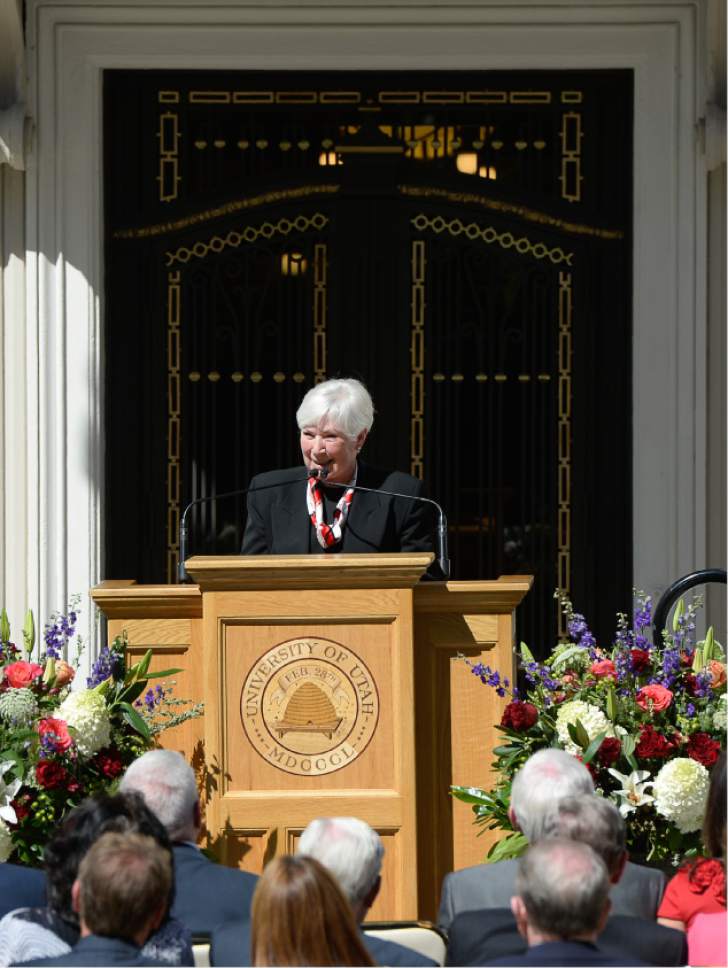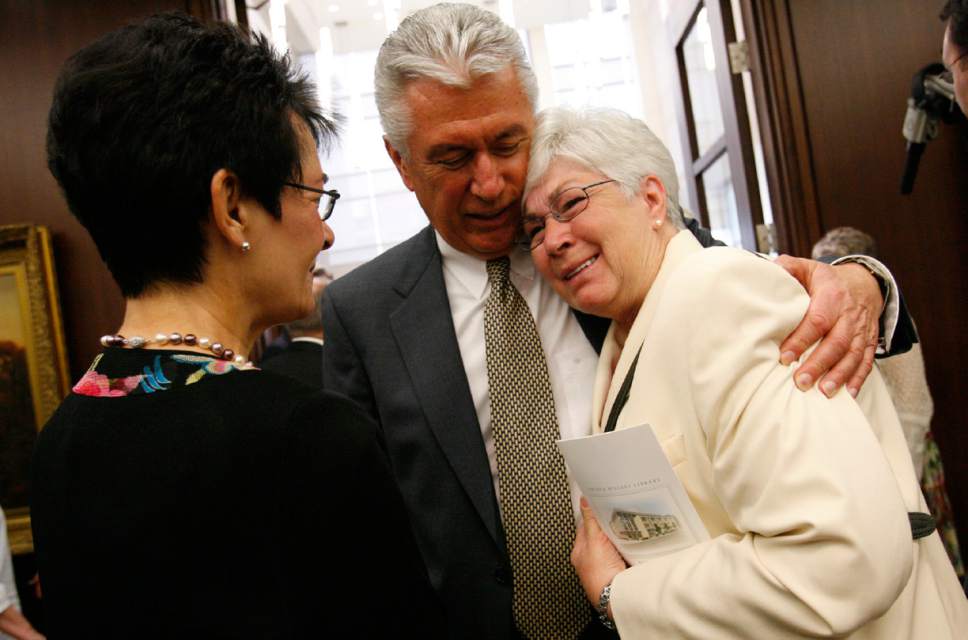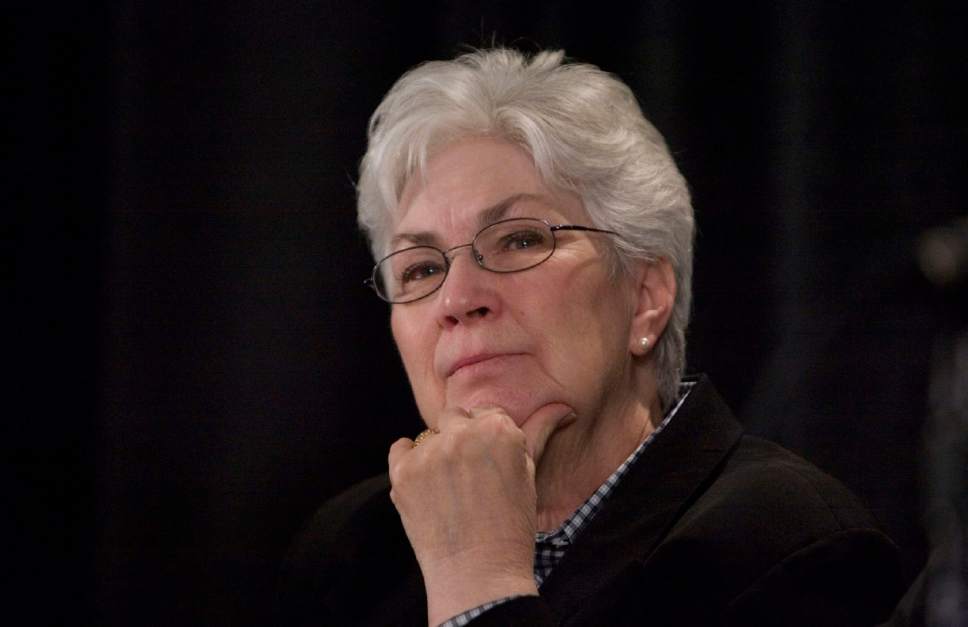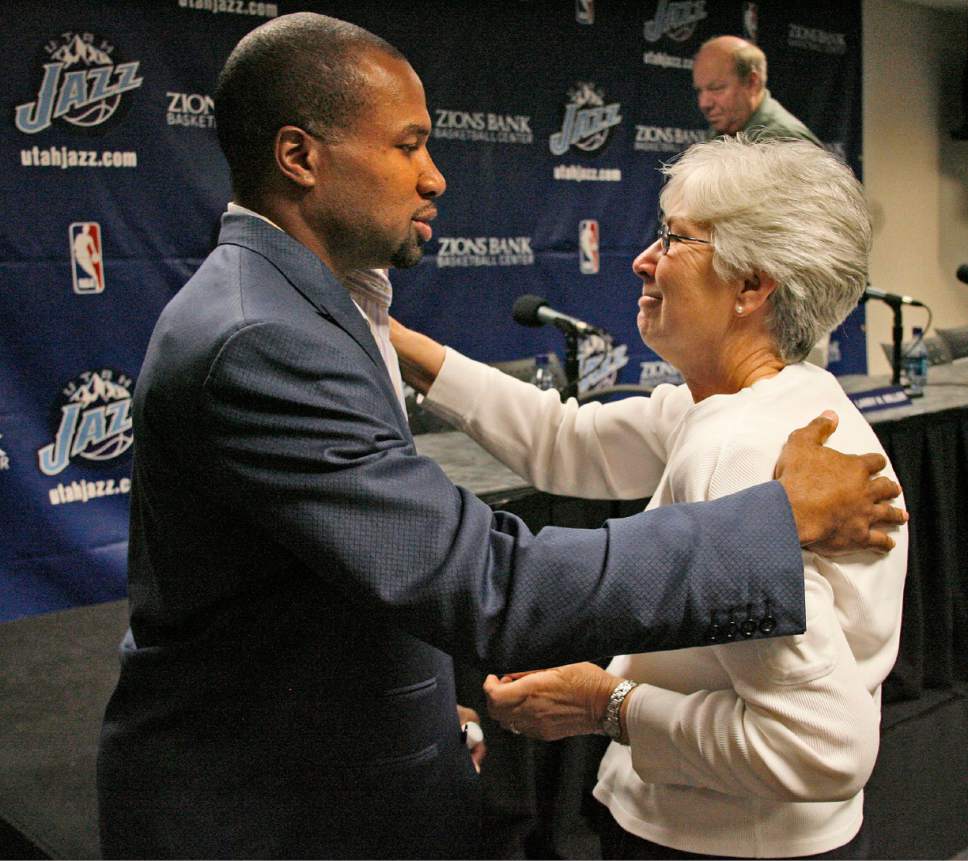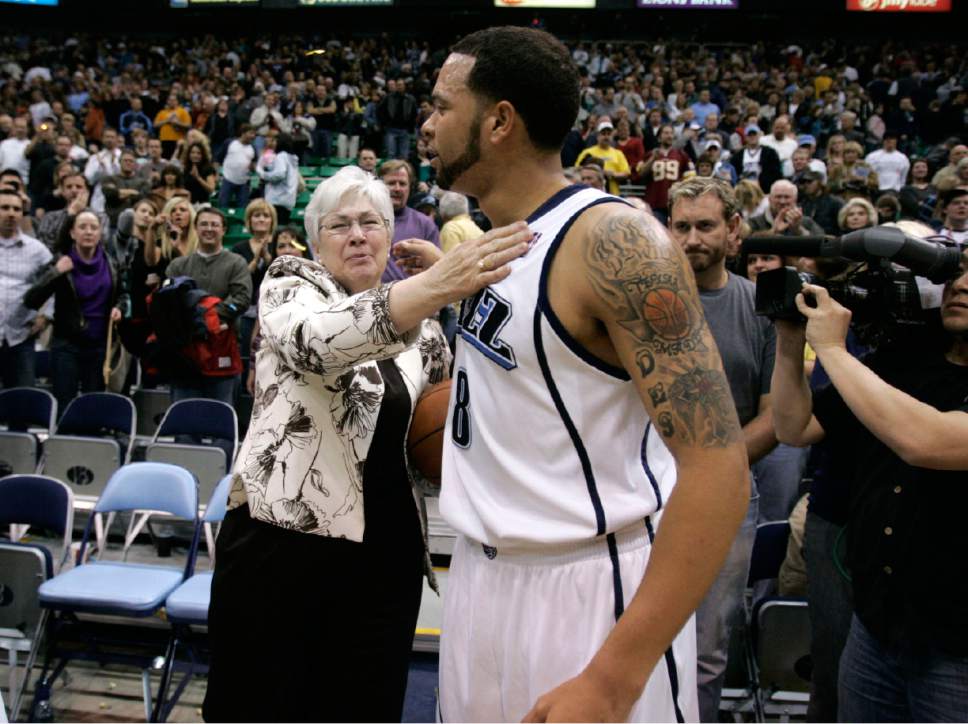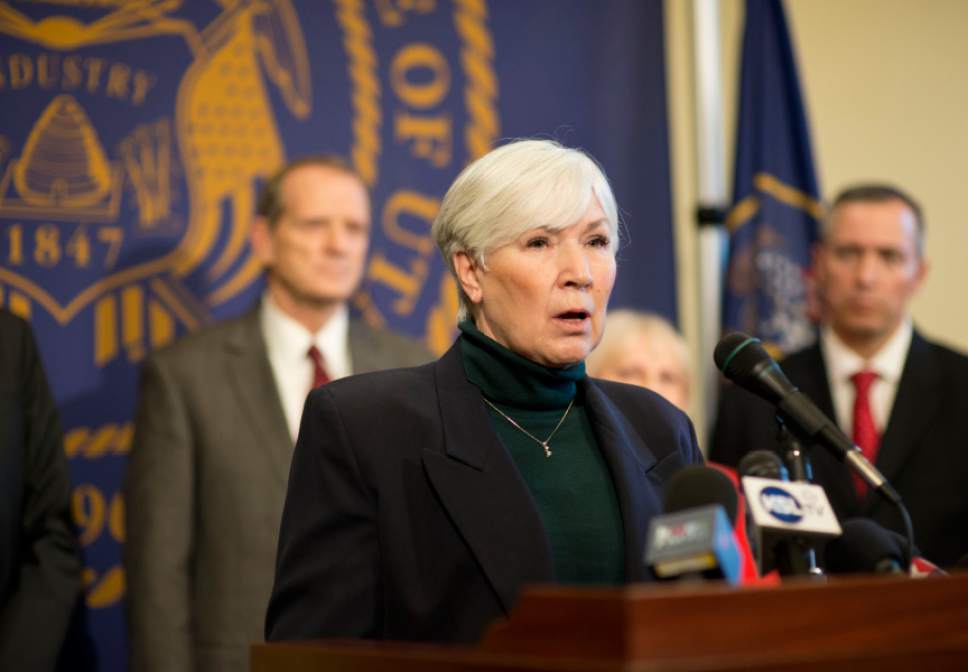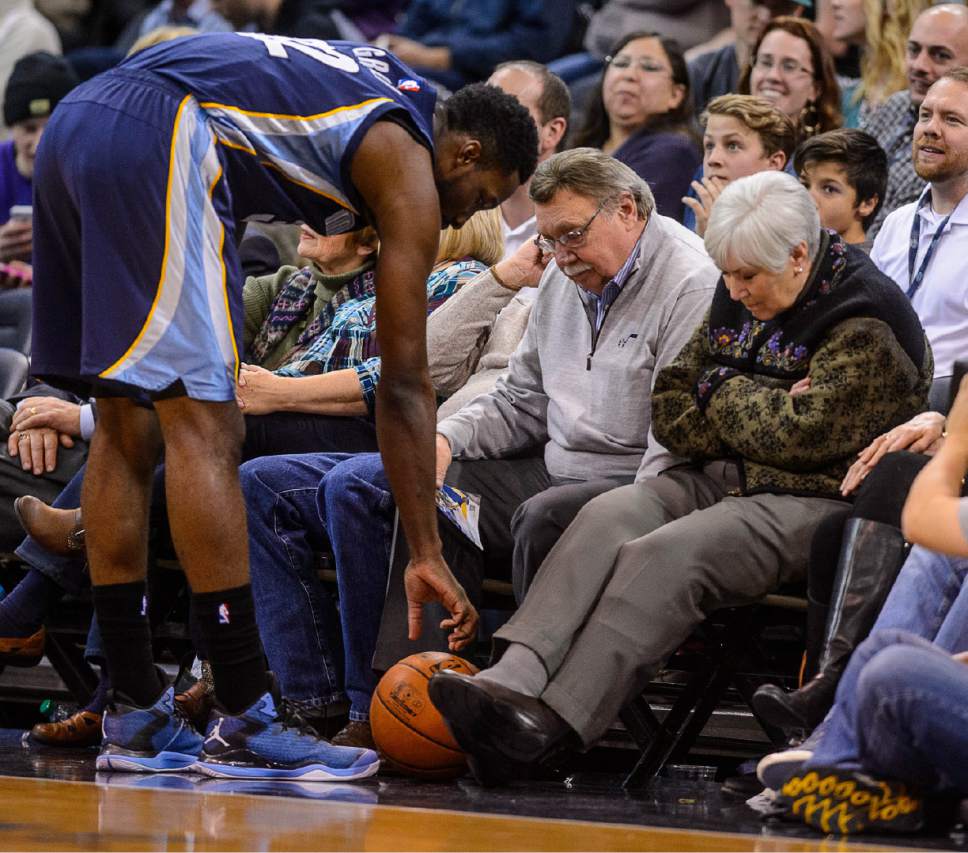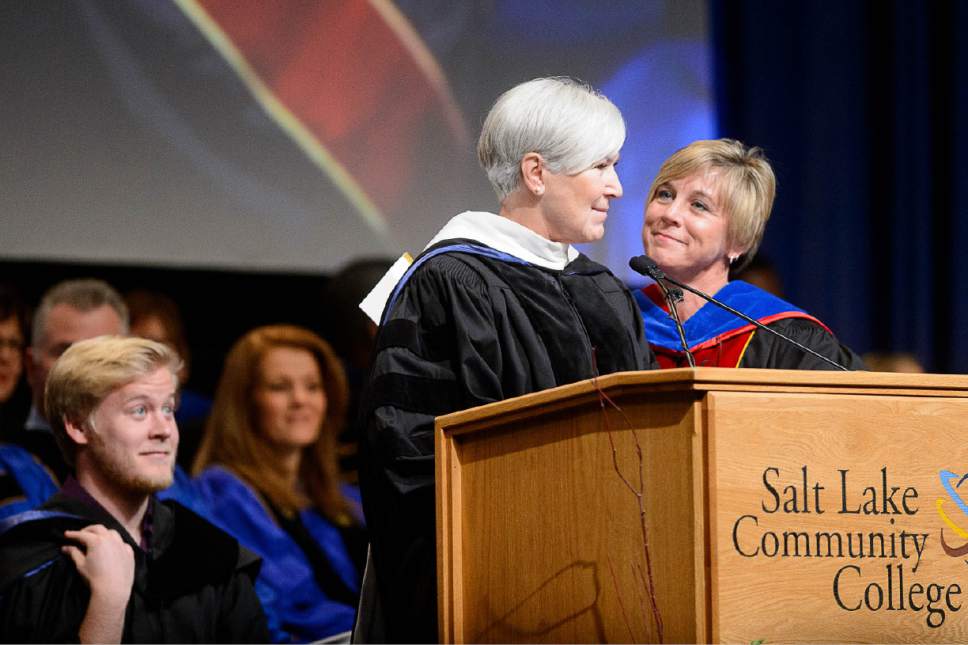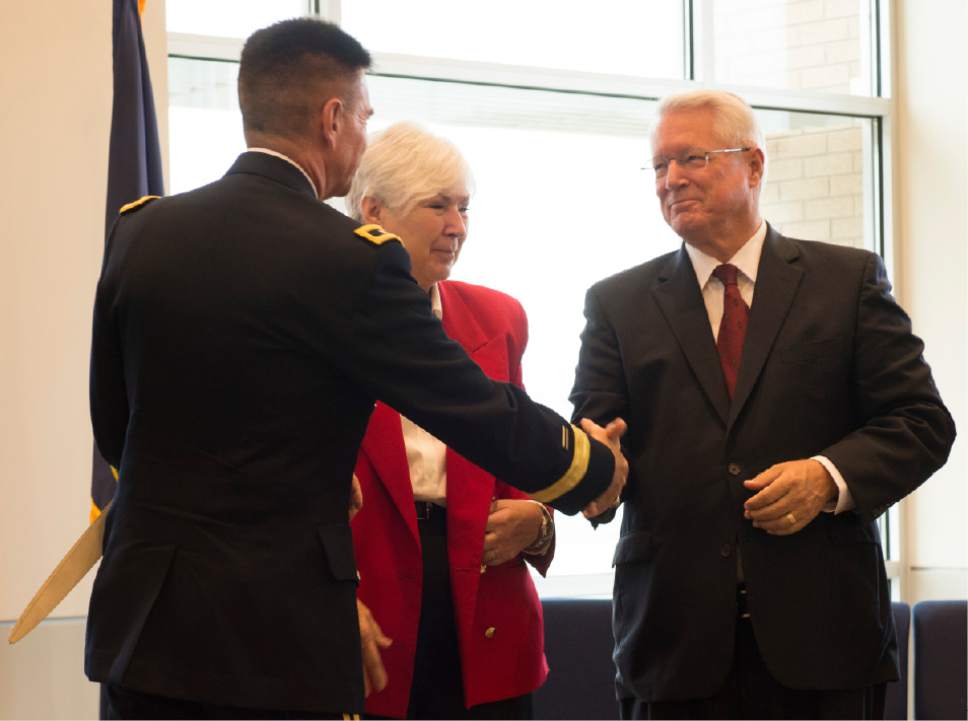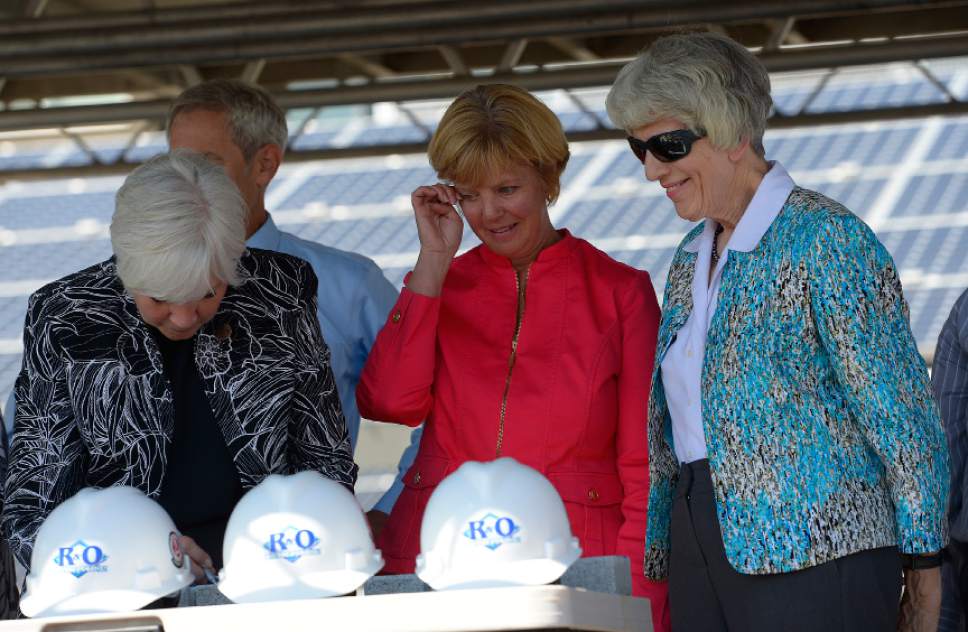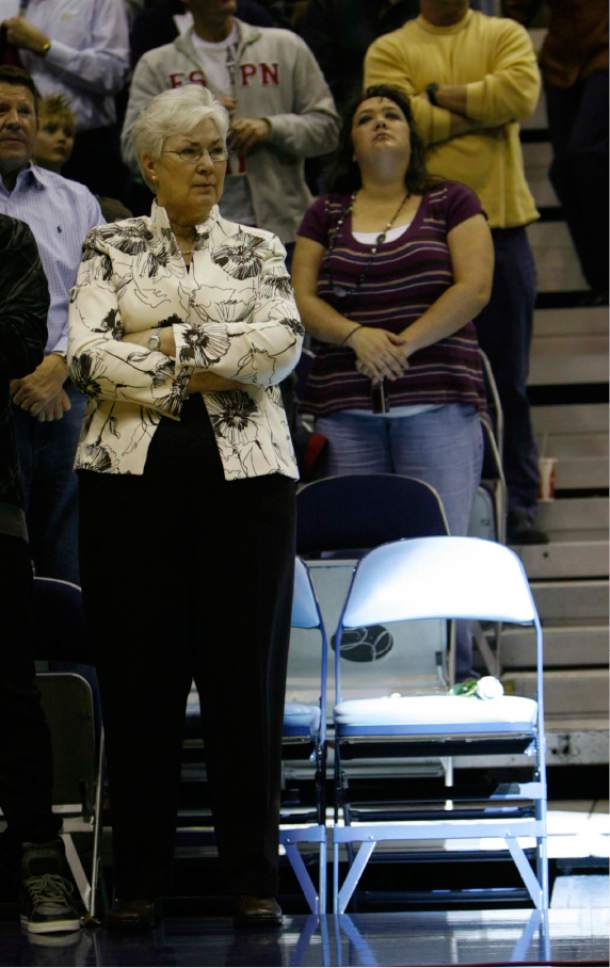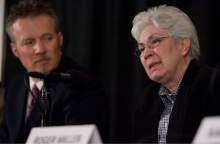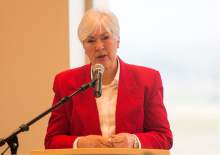This is an archived article that was published on sltrib.com in 2017, and information in the article may be outdated. It is provided only for personal research purposes and may not be reprinted.
Gail Miller still owns the first car she ever bought.
It wasn't the Ford T-bird she had seen advertised in the paper, the one she really wanted. Instead, it was a 1963 red Ford Falcon Sprint convertible, the one her boyfriend, a guy named Lawrence, wanted her to have … so he could drive it and race it.
The salesman worked Gail, 19 at the time, hard with the deal.
"Come look at this," he said.
"No," she answered back. "I don't like that one."
"What if I knock a couple hundred dollars off the $2,600 sticker price?"
"No," she said.
"What if I take it down to $2,200?"
That's when a rather persuasive Larry joined ranks with the sales guy.
"He could see the potential for drag racing in that car," Gail says, 54 years later. "He cut the wheel wells out to put slicks on it, and I financed the whole thing through the credit union at the telephone company where I worked. Every time he raced it, he'd break something, and I'd have to go get more money. By the time I got that car paid off, I think it was about $10,000."
Eight years later, after Larry had landed on the trailhead of his iconic automotive career, he bought a sparkling exact twin to the Falcon Sprint and gave it to Gail, who by then had become his wife, as a sentimental gift. She now had two Falcons. He doubled her modest prize.
Decades later, and eight years after Larry's death, Gail has repaid her late husband now by doubling his prize — the Larry H. Miller Group of Cos., a corporate empire that features more than 80 businesses, operating in 46 states, including 63 auto dealerships, 17 Megaplex Theatres with 180 screens, the Utah Jazz, Vivint Smart Home Arena, 110 Fanzz stores, a financing outfit, an advertising agency and numerous other enterprises, all of which combine to do billions of dollars of business and provide jobs for 11,000 employees.
Gail Miller is the head of all of that and more, overseeing a massive company restructure, guiding the Miller family's philanthropic efforts and involving herself in causes and community-related issues.
"Larry had this realization that what we were doing was not just for us," she says. "He loved providing for other people. This wasn't a vehicle for us to get rich. It was a vehicle for us to be stewards over … whatever riches we had available with which to do good. That's kind of been our mantra."
Clark Whitworth, chief executive officer of the LHM Group, who worked with Larry for three decades, says: "Gail's really stepped up. She doesn't let things get out of control. Her hair is not on fire, always chasing things. … She's exceeded expectations. And she's definitely in charge."
She's like the character in the old E.F. Hutton commercials: When Gail talks, everybody listens.
If the Jazz are making a big personnel decision, general manager Dennis Lindsey says he and his staff work through whatever scenario is at hand, research it, come to a conclusion, then take it to the owner: "You get into a Rudy Gobert extension, for example. We make suggestions, and she decides and signs off on it. She asks the best questions. I always enjoy it when she's in the room."
If the automotive side or the retail side has a significant decision or issue, same thing.
The family, ditto.
"There's an automatic filter," says Steve Starks, president of LHM sports and entertainment. "How would Gail feel about this? If it will disappoint or embarrass her, it's not worth doing. She carries that kind of respect."
Gail says she's channeling Larry: "If he were here, he would be doing the same things. I hope that I'm doing this right. I think that I am. It feels right. I don't want to be the one who causes it to crash and burn."
'We get to eat tonight'
Miller doesn't pretend to hide the fact that the company Larry started with a single dealership in Murray back in 1979, in partnership with her, has made her and her family as wealthy as King Farouk. She just doesn't feel comfortable emphasizing it or dwelling on it for too long. When confronted with recent speculation by Forbes that she is the richest person in Utah, Miller turns her head and waves a hand and an arm, as if to swipe the notion off the screen of anybody's consciousness.
She gets the enormity of the enterprise and feels its weight. But it does not define or confine her, she says, because she was what she is long before the wealth arrived, all the way back to when she was growing up in the Marmalade District of Salt Lake City, in a humble home at 366 Quince St.
The old house looks different now with its black and white paint rather than the natural brick colors featured when Miller was raised there, seven decades back. But the steps are pretty much the same, 10 up to the landing, then seven more to the front door.
"Sometimes, we'd watch for my dad to come home with a sack of groceries," she says. "And then we'd yell, 'We get to eat tonight!' I remember going to high school without having breakfast and no lunch and, you know, you just get used to it. We had one light bulb in the house, and, sometimes, we didn't have a comb, so I'd comb my hair with a fork. I baby-sat, worked for a lady whose husband was a doctor, making 50 cents an hour. There were times when I worked all day, came home with four dollars, and my father asked, 'Can I borrow your four dollars to buy gas to get to work?'"
The family — nine children with Gail at No. 6 — had no washing machine until Gail bought one after getting her job as a phone operator when she was a high school senior. Her father struggled to keep consistent work and her mom was a homemaker. But Gail's parents were visionary and principled, qualities they passed on to their daughter.
"There were difficult times," she says. "But what I learned is to get by with what you've got. When I was young, every time I went up the steps to that house, I thought, 'I'm a princess. I live in the best house on the street! And everybody's watching me go into my castle.' I don't know if I was just creating a fantasy world or what, but I really thought that way.
"We were taught that we might be poor, but we're just as good as anyone else. Being poor didn't diminish me. It magnified me. It taught me I'm OK whatever my circumstance. I could be poor or rich, but I'm still the same person."
For richer, for poorer
Gail enrolled at the University of Utah for a short period, but dropped out after her father suffered a stroke, feeling the need to help support the household.
Years earlier, into all of that optimism and determination wandered young Larry Miller.
Through a friend, he got Gail's number, phoned up and blurted out, "I hear you're cute. Wanna meet?"
They did, and Gail wasn't all that impressed. Neither were her parents.
That changed over time.
The couple dated from 1959 until 1965 before marrying.
"Larry was fun," she says. "We talked a lot and he paid attention to me. When someone pays attention to you, you think, 'He must think I'm pretty neat.' We kind of found solace in each other, I think."
After those six years, Gail grew tired of waiting for Larry to move off his anchored spot. She says: "We talked about marriage, but he just never …"
Proposed.
Gail told her longtime beau essentially to get on with the getting on or to pound sand. She suggested a time — a day in March 1965, when she had a vacation from the phone company — and a place — Salt Lake City's Memory Grove — for a wedding. He agreed, because he didn't want to lose the best thing that had ever happened to him.
"Larry was a different person back then," she says. "He couldn't figure out what he wanted to do. He was smart and capable, but couldn't apply himself. He didn't do well in high school. He was possessive of me and very controlling. Even after we got married, he had six or seven jobs in the first five years. I had my job, and that's what kept us stable."
She was the one buying the Falcon Sprint convertible, after all.
Beyond that, Gail says, "He had a low emotional IQ."
While she saw potential in him, she says she "never would have expected him to do what he ended up doing. We didn't ever talk about being successful until long after we were married."
When that success — stretched out over more than a decade — came, it landed like a cannonball. Larry learned the car business in Utah and in Colorado, starting as a scrub and working his way up to parts manager, general manager and operations manager over a five-dealership conglomerate.
"Larry was working 90 hours a week," Gail says. "I was raising the [five] kids, taking care of the house, fixing bikes, doing a lot of things. It was really hard and it was really lonely and it was not good for the kids. They missed out, and they got bitter. They weren't perfect kids. We had our troubles.
"There were times when I wanted a divorce, but, luckily, he didn't. And then there were times when he wanted one and I didn't. It's a good thing we didn't want one at the same time or we wouldn't have made it. But we understood the commitment we had and did our best to get over those hurdles."
Playing to win it all
Not long thereafter, when Larry and Gail came back to Utah for a friend's wedding, Larry met with Hugh Gardner, the owner of a Toyota dealership in Murray, and asked him, half-jokingly, when he was going to sell his store to him. Gardner said: "How about today?"
Within hours, on April 21, 1979, Larry Miller was the owner of his first store. He came back to his mom's house, where he and Gail were staying, and said: "What if I told you I spent a million dollars today?"
Gail's response: "I didn't know we had a million dollars."
They didn't. They had $88,000. They got a loan from a bank and Larry's uncle.
"It was scary," she says. "When you take on paying the salary of 30 other people, it's very scary."
How about 11,000?
That's what the Millers' empire has turned into. The path from point A to point Z was filled with acquisition after acquisition. One store turned into six, six turned into 12, 12 turned into 24, and so it went.
"Ninety percent of Utahns are in some way touched by — and use — the services that the Millers provide," says Scott Anderson, president and CEO of Zions Bank, who has known Gail for 27 years. "In a number of Dan Jones surveys, where he asks about the most respected people in the state, people who have the most influence, Gail's always at the top of the list."
She didn't set out to be the most respected anything.
"We had no idea we would increase our business, you know?" Gail says. "One store can make a good living for you, but things kept coming to us. I'd always ask Larry, 'Why do we need one more?' And he said, 'We can do so much good with it. We can create jobs, we can use the money for good things.' It was just the evolution of our lives."
Part of the evolution was the Jazz. Larry put up $8 million for half the team, substantially more than he was worth at the time, drawing on loans, with an additional $17 million payment later. By the end of the 1980s, the Millers owned the team outright, a team that otherwise likely would have moved to another city. Instead, the Jazz flourished on the court and off it, and Larry soon thereafter was constructing a building — first called the Delta Center and now known as Vivint Smart Home Arena — for his franchise.
Like many of his investments, it was a visionary move by Miller.
His total outlay for the Jazz was less than $30 million. The club's estimated worth now is somewhere around $1 billion.
His key adviser: Gail Miller.
"Everything was a discussion we had together," she says.
Gail was once asked if the Jazz were really trying to win a championship, or if ownership was pleased just with turning a profit and competing well. She snarled at the question, echoing the words of former New York Jets coach Herm Edwards: "You play to win the game. You play to win a championship."
Says Gail: "I've never hesitated to say that."
Lindsey says he feels two emotions around his boss: "I think about what it would be like to hand her a championship trophy, and I never want to disappoint her. She's great to work for, a jewel for the community."
Tough but tender
Underestimating Gail Miller would be a mistake for anyone foolish enough to do so. Before he died, Larry said his wife, in many ways, was a better judge of situations and circumstances — and people — than he was. "Don't mess with Gail," were his exact words.
"There's no pretense about her," says Steve Miller, Gail's son. "That's what makes her special. She's not one thing here and then another there. She's Gail Miller in every setting, easy to be around, genuine. It's like people are in the presence of their grandmother. There's a big difference between that and being a pushover. She's smart, perceptive and can connect the dots. She almost has a sixth sense about things."
Says Whitworth: "You're not going to intimidate her. … She can be tough."
She's had to be. She was painfully aware her husband's health was declining over the last 10 to 15 years of his life. She begged him to take the necessary steps to prolong his existence, and he tried, but, ultimately, could not stop the slide. He suffered from diabetes and other attendant illnesses, even as he made significant and masterful moves to position his company to survive and thrive in all kinds of economic conditions.
"He spent probably the last 10 years saying, 'If anything happens to me, you need to know this,' " says Gail. "He'd come home, sometimes climb into the bathtub, while I sat on the floor, and tell me about the events of the day and decisions he had to make. He made them by talking them through with me. I understood what was going on. I knew the people and the challenges. I didn't know everything he knew, but I knew a lot of it."
Gail says her husband, in so many areas, could will his way through problems and find solutions, but when his health failed him, his will was not enough. He died in February 2009.
"I took care of him the best I could," she says.
The week before Larry passed, his family stayed at his house, watching family videos, and visiting with him and other family members, reminiscing and celebrating a life that was at times flawed, but was also filled with remarkable achievements. At his death, Gail says, the plumbing backing up in her eyes, "We were as prepared as we could be."
Greg Miller, Larry's eldest son, had been inserted as the LHM Group's chief executive officer. But Gail was the company's owner. She sat in on regular meetings to stay informed about the business's major moves.
"My dad positioned the company from a debt perspective that allowed us to go forward," Steve Miller says. "Greg added a lot of horsepower to the machine. The structure allowed for it. We spent money to make money. Coming out of the recession, we did a lot of things right. Then, the economy kicked in, adding oxygen to the fire."
Throughout, Gail's presence was evident.
"I felt a profound responsibility to make sure, even though I wasn't running it, that things went well, that people were doing what needed to be done, that I oversaw it, that Larry's wishes were being honored," she says.
Over time, the company leader saw the need to create a more corporate structure, one that included a board of advisers/directors and a more pragmatic approach as the company went throttle up: "I found a note Larry had written that said there needed to be a board created, a system of checks and balances, so nobody would go off in the wrong direction," she says. "That was an affirmation that what I was thinking was right."
Clearly, Gail Miller is not afraid of taking on hard jobs and doing hard things. But she wants to stay grounded.
"I want to be looked at as a common human being — interactive, approachable and kind," she says. "There are people who are intimidated by me because of my position. But once they get to know me, I mean, I've had people say, 'Whoa, you're a real person. You're just like everybody else.' That's a compliment to me."
Make more to give more
Still, she's at the top of the company's power grid.
Whitworth subsequently has been installed as the company's CEO. A 12-member board of directors, six of whom are from outside the family, including close Miller confidant Denny Haslam, with Gail at the head, guides the outfit as it experiences growth, and plans for the future.
"I'm 73 years old," Gail says. "At some point, I need to know I can turn this over with confidence and know it's going to be our family's legacy that will live on for a hundred years."
She would prefer at some future time to have a family member either run the company as CEO or steer it from the chairman's seat.
She's also the matriarch of a family that, along with her husband, Kim Wilson, includes 73 people — kids, spouses, grandkids, and great-grandkids. That, in and of itself, is a huge undertaking. Mixing in the business side makes it that much more complex.
"A big challenge for me is the family," Gail says. "Making sure the family understands who and what they are and can be, and living up to their potential, without being entitled, without thinking they deserve things. I want them to earn what they get, and be good, solid citizens. If they do that, then, I think my job, and my kids' job has been done well."
Leading both the family and the family-owned business is a full plate, Steve Miller says: "It's difficult to separate the two because they've been so intermixed. That's all it's ever been. It's tough to balance both. It's tricky. It's an art, not a science."
Which is to say, is what's best for the business what's best for her adult children and is what's best for her children what's best for the business?
Differences of opinion sometimes arise, and, when they do, it's been left to You-Know-Who to look for solutions and resolutions.
In that way, she is the chairman and the … chair-mom.
Meanwhile, business booms.
"Our business touches almost every state now," Gail says. "When you're spread out that far, you need to have something that can teach everybody the same thing about what we are, who we are. You can't stay status quo, because there's no such thing. You either dwindle or you grow. I could see in the future, us getting into some totally unrelated businesses. And who knows if the automotive business will morph into spaceships, or whatever. We have to be prepared for change."
One thing that Gail says has not changed and will not change is the charitable giving done by the Miller family and its company. She has been a champion for education, health, women's and children's causes. All told, the family and LHM is involved with 400 different charities.
She has also involved herself in community issues, taking a leadership position in the Count My Vote initiative and playing a similar role in Salt Lake City and Salt Lake County's efforts to increase and upgrade the community's homeless facilities.
"She's spent a lifetime providing services for the people of Utah," Anderson says. "But she's willing to use the power that comes from that in doing good for humanity."
Gail says the Larry and Gail Miller Family Foundation's goal is, in fact, to funnel the resources from the business to a positive end: "After all the work is done, there's going to be a pile of money that's going to be there to do philanthropic work."
One of her sizable challenges now is deciding where current and future donations should go. Giving money away, she says, is easy. Deciding exactly where it can do the most good is not.
"Larry was philanthropic," says Jay Francis, an LHM executive vice president. "Gail put that on steroids. She believes the communities where we do business should be better because Larry Miller is there. She wants the company to make more money so it can give more money away."
One example is this: 311 of LHM's employees' children are on company-funded scholarships at 83 universities and colleges. The formal college education that Gail could never attain for herself is, in fact, being realized for — and by — many others on her account.
"There's a lot of good to be done," she says.
The once dirt-poor girl, then, who never saw herself as disadvantaged, who saw only a princess atop those 17 steps, entering her castle, a castle with only one light bulb and no dishwasher, is helping other girls and boys, women and men, find and keep employment, find opportunity for enrichment in their lives, find a path to an American dream that may not match her own in scale and scope, but that matches it in meaning, at least to her and to them.
— Gordon Monson co-hosts a daily afternoon radio show with Spencer Checketts on 1280 The Zone, which is owned by LHM. —
About Gail Miller
• Born in Salt Lake City in 1943.
• Marries Larry Miller in 1965.
• Has five children.
• Helps Larry purchase first car dealership in 1979.
• Signs on with Larry to co-own the Utah Jazz in 1985; purchases entire NBA franchise a year later.
• Couple finance most of the construction costs of the 19,911-seat Delta Center in 1991.
• Larry Miller dies in 2009.
• Remarries, to Kim Wilson, in 2012.
• Owner LHM Group of Cos., which includes more than 60 dealerships, 110 retail stores, theaters, an advertising agency, a financing company, the Utah Jazz, Vivint Smart Home Arena, and multiple other enterprises, all of which combine to employ some 11,000 people.
• Family and company have contributed millions of dollars to health, education, children's and women's causes, and in giving aid to the homeless, and other charitable endeavors.
• Involved in community activism, including Count My Vote and homeless issues.
• Listed by Forbes and other publications as one of Utah's wealthiest people.



